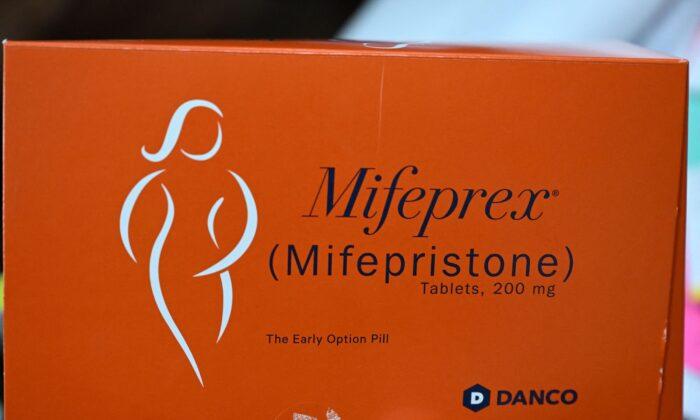The company that makes the abortion pill mifepristone urged the Supreme Court to throw out a challenge to loosened regulations that made the pill more accessible to women.
The ruling returned the regulation of abortion to the states.
The manufacturer, Danco Laboratories, makes mifepristone, which is also known as mifeprex and RU-486.
A medication abortion generally involves the use of mifepristone, which blocks progesterone, a hormone, and misoprostol, which induces contractions. Misoprostol, which is widely available because it has many medical uses, isn’t an issue in the current litigation.
The Court’s decision in the extensively litigated case could affect the availability of the drug.
In 2016, the U.S. Food and Drug Administration (FDA) changed the drug’s official label and extended the cutoff for its use from 49 days of gestation to 70 days.
At the same time, the agency allowed the drug to be prescribed with only one in-person visit and halted the requirement that prescribers report nonfatal adverse events related to the drug.
In 2021, the FDA allowed prescriptions to be sent by mail.
Opponents of the abortion pill argue that the 2016 and 2021 regulatory changes removed important safety protocols and put women at risk.
The Supreme Court will hear two consolidated cases, Danco Laboratories LLC v. Alliance for Hippocratic Medicine (AHM), and FDA v. AHM, together on March 26.
The Court, which granted AHM’s petitions on Dec. 13, 2023, is expected to deal with the regulatory actions from 2016 and 2021 but not with the original approval of the drug that took place in 2000.
The dispute began to heat up last year when U.S. District Judge Matthew Kacsmaryk of Texas, an appointee of President Donald Trump, held that the FDA was wrong to approve mifepristone for public use in 2000 and that the agency had deliberately dragged out judicial review of the drug for years.
The judge also found that the FDA had improperly lifted restrictions related to accessing the drug. He issued a preliminary nationwide injunction retroactively staying the FDA’s approval.
Judge Kacsmaryk wrote that the FDA had not properly assessed the risks posed by the drug before approving it, buckling under political pressure to get it on the market.
The U.S. Department of Justice (DOJ) appealed against Judge Kacsmaryk’s decision, but the conservative-leaning U.S. Court of Appeals for the 5th Circuit refused to block most of the order.
The 5th Circuit held that the FDA’s actions in 2016 and 2021 were probably unlawful—a finding the FDA and Danco have asked the Supreme Court to review.
In August 2023, the 5th Circuit upheld the district judge’s restrictions on the abortion pill, holding that the FDA failed to give proper consideration to public safety concerns when approving it.
The 5th Circuit noted that the AHM and the other plaintiffs argued they had “associational standing” because the various organizations involved in the lawsuit have members who “are likely to sustain injuries as a result of FDA’s actions.”
The court found the plaintiffs “made a ‘clear showing’ that their members face injury with sufficient likelihood to support entering a preliminary injunction.”
The DOJ appealed to the Supreme Court, which blocked the injunction over the original approval of the drug, allowing mifepristone to remain on the market.
Brief Challenges Standing
In a new brief filed on March 14, Danco’s attorney, Jessica Ellsworth of Hogan Lovells in Washington, echoed Ms. Prelogar, writing that the lower court’s decision “to enjoin FDA’s 2016 and 2021 decisions was unprecedented.”Moreover, the circuit court’s decision should be reversed because the AHM’s “claim to standing combines a statistical theory of future injury to unnamed members … with claimed past injury by a few members … for parties unregulated by the challenged action … without linking traceability or redressability to the challenged action.”
The group misquotes “FDA documents [and] declarations that don’t say what respondents claim, and alternative theories the court below refused to endorse. None fills the gaps in respondents’ standing argument,” Ms. Ellsworth wrote.
Danco’s lawyer also argued the 5th Circuit erred when it ordered a return “to pre-2016 labeling and conditions of use as preliminary-injunction relief.”
Although the AHM dismisses “concerns of industry-wide destabilization” as a result of the circuit court ruling, “not a single industry member is on respondents’ side,” she wrote.
The Pharmaceutical Research and Manufacturers of America (PhRMA), which is “the leading industry association,” as well as almost 350 pharmaceutical companies, executives, associations, and investors, said in a PhRMA brief that the 5th Circuit’s decision “poses a serious threat to the health and stability of the nation’s biopharmaceutical industry,” she added.
The ruling “threatens a seismic shift in the clinical development, drug approval, and post-approval processes,” Ms. Ellsworth wrote, again quoting the PhRMA brief.
Attorney Erik Baptist of the Alliance for Defending Freedom, which is representing AHM, told The Epoch Times in January that he was hopeful on the issue of standing, an issue that he said “about 75 percent” of the other side’s briefs focus on.
“Every judge who has looked at it so far, and every court has agreed that what the FDA did is so egregious and unlawful that it’s well within the realm of the court’s jurisdiction to strike down those agency actions to take away those common-sense safety standards,” Mr. Baptist said at the time.
Idaho Statute Challenged
Meanwhile, the Supreme Court will take up a separate abortion-related case on April 24.Moyle v. United States, which has been consolidated with Idaho v. United States, concerns an Idaho law that forbids abortions except when “necessary to prevent the death of the pregnant woman” or during the first trimester when the pregnancy was caused through rape or incest.
Idaho asked the Supreme Court to put on hold a lower court order that preliminarily enjoined the state’s abortion law, which forbids abortions except when “necessary to prevent the death of the pregnant woman” or during the first trimester when the pregnancy was caused through rape or incest.
On Jan. 5, the Supreme Court granted Idaho’s request to stay the lower court order, pending the outcome of the case at the High Court.
The lower court had found that the state statute was preempted by the federal Emergency Medical Treatment and Labor Act (EMTALA). Federal preemption means that a state law that conflicts with federal law is invalid.
The act was passed by Congress in 1986 “to ensure public access to emergency services regardless of ability to pay,” according to a Centers for Medicare and Medicaid Services (CMS) summary.
The Social Security Act requires hospitals that participate in Medicare and provide emergency services “to provide a medical screening examination (MSE) when a request is made for examination or treatment for an emergency medical condition (EMC), including active labor, regardless of an individual’s ability to pay.”
Such hospitals are also “required to provide stabilizing treatment for patients with EMCs,” according to CMS. Stabilizing treatment includes abortions, the Biden administration argues.
Soon after the Dobbs ruling, CMS issued legal guidance asserting that EMTALA could mandate abortion and supersede state abortion laws, which critics say effectively creates a new federal right to abortion in hospital emergency rooms.
The Supreme Court’s decision in Moyle v. United States is also expected by June.







